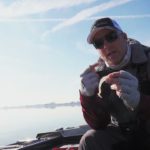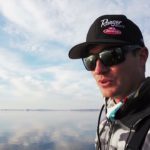The Games Walleyes Play
 The middle of summer can be a tough month to fish for big walleyes.
The middle of summer can be a tough month to fish for big walleyes.
The weather gets hot and sticky. It’s uncomfortable to be on the water most of the day. If the body of water we’re fishing isn’t crystal clear, it’s algae-stained. And in most of the small or shallow lakes, the water temperature rivals that of bath water.
It’s also a time of year when trophy walleyes resort to child’s play. Unfortunately, it’s not usually a game of tug of war. More often, it’s a game of hide and seek.
Those halcyon days of spring and fall when big walleyes are more predictable because of water temperatures, substrate and their basic biological needs are months away.
Now it’s a guessing game for which there are no definitive answers. However, there are certain clues that can help anglers locate these fish even when they’ve dug into their best hiding places.
Choosing a destination is one of the most important considerations in catching quality ‘eyes in the heat of summer.
Obviously, you want to go where the largest populations of adult fish exist, but you also want to go where you can find the two factors that most affect their summer lives – water temperature and the availability of forage.
The Great Lakes and larger natural lakes and reservoirs are always a good choice. Because of their massive size and tremendous depth, they generally don’t warm to the same temperatures as smaller and shallower lakes. And when they stratify in the summer, they create layers of water that are different temperatures, which means walleyes can always find a comfort zone.
On the other hand, pinpointing a school of big walleyes on these big lakes can make you feel like Little Jack Horner. You might stick in your thumb and pull out a plum, but you might get your hand slapped, too.
Fortunately, even July walleyes have certain needs, and that makes them somewhat predictable. In fact, they can’t live without an abundance of food and good levels of oxygen in the water.
Baitfish don’t usually haunt the shallows in the summer and oxygen levels aren’t as good as they are elsewhere except where there is consistent wave action. I’ve very rarely hooked up with big walleyes in water less than 10 feet deep during the dog days of summer unless I’m fishing at night or on a windy, overcast day.
Most of the time, I’ve found these fish either suspended over open water around large schools of baitfish or prowling deep rock piles and reefs where the water is cooler and they can escape summer’s harsh light.
Suspended fish, common in the Great Lakes, tend to roam with those schools of alewives, smelt or even chubs so it’s a new game of hide and seek every day.
Rock fish usually aren’t present in tremendous numbers like suspended fish can be, although there are always exceptions to the norm. Many times, I’ve located walleyes on hard structure, but only been able to catch one or two, even though I can see several more fish on my Lowrance LCX-111 HD sonar unit. When that happens, I move on to another reef or rock pile and return to the previous one later.
 The good thing about summer walleyes is that when you find them, you can usually get them to eat whether they are suspended or tight to structure. Because their metabolism increases with the water temperatures, they need to eat more, which is one reason they move away from minnows and insects to larger baitfish species and crawlers fished on spinner rigs.
The good thing about summer walleyes is that when you find them, you can usually get them to eat whether they are suspended or tight to structure. Because their metabolism increases with the water temperatures, they need to eat more, which is one reason they move away from minnows and insects to larger baitfish species and crawlers fished on spinner rigs.
Over open water, I like to spread my lines using Off-Shore planer boards and troll crawler harnesses with fairly large spinner blades. Mix the depths using keel weights or snap weights until you find the most active location, and then get everything into the same zone.
Sometimes, a certain depth produces the best fish. Sometimes, a different depth will produce more but smaller fish. Sometimes, it pays to move off to the edges of a school of suspended fish when looking for the biggest specimens.
Crankbaits work at times, too. I like a bait with a fairly large profile and plenty of action, and one that I can run as fast as 3-4 mph. Normark Shad Raps in size 8 and 9 are usually good choices, as are Storm ThunderSticks and Deep Junior ThunderSticks.
For those rock fish, it can be tough to keep a trolling presentation in the strike zone, so a Lindy Rig is my go-to technique. I like snells as long as 10 feet in clear water and I add a colored bead in front of a size 4 or 6 bleeding red bait hook. Live bait can range from crawlers and leeches to red tail chubs.
One key to rigging is speed control. It’s critical to make sure those fish get a long, hard look at what you’ve got to offer. I speed up over stretches where I don’t see any fish on the Lowrance, then slow down to a crawl when walleyes show up. I’ve also found that fish that appear slightly off the bottom seem to be more cooperative than those that are buried tight to bottom.
Sometimes, I hover directly over a particular fish with a Lindy Rig or switch over to a slip-bobber presentation. It’s like putting a bowl of ice cream in front of someone. They may say they don’t care for any, but if you sit it in front of them, most people will eat it sooner or later.
Whether you target suspended fish or reef fish, stealth is critical. By July, big walleyes have seen plenty of lures and experienced plenty of boat traffic, and when your margin for error is small to begin with, everything you can do to disguise your presence is a plus.
One of the tools I use to that end is my MinnKota Engine Mount electric trolling motor. It’s mounted to my Mercury Outboard and it allows me to move quietly and efficiently around areas I know are holding fish. The Engine Mount models are available in 12- to 36-volt systems capable of 55 to 202 pounds of thrust.
Another weapon in my arsenal is Yo-Zuri Hybrid fishing line. It’s a blend of nylon and fluorocarbon that offers the ultimate in invisibility while providing abrasion resistance, sensitivity, flexibility and stretch.
Catching big walleyes in July is always a game of hide and seek. Take it slow, be quiet, be patient and trust your electronics. Tug of war is a lot more fun.





